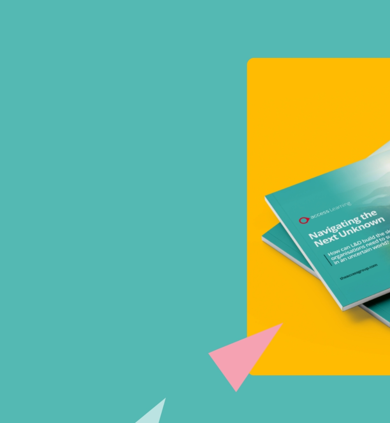From Reactive to Ready: 7 Steps to Build Learning Agility in the workplace
Skills are changing faster than ever, while traditional L&D approaches can't keep pace with the speed of business transformation. The gap between what organisations need and what L&D can deliver is widening, requiring a fundamental shift from reactive to strategic.
In this article we provide a practical seven-step framework to transform your L&D function from firefighting to future-ready through building workforce agility.
Why learning agility is essential today
The numbers tell the story: 39% of core skills will need replacing by 2030. Skill half-lives have plummeted from 26 years to less than five. Meanwhile, 70% of employees are already using AI without formal training from their employers.
The business case for learning agility is compelling. Companies with highly learning-agile executives achieve 25% higher profit margins compared to their peers, while learning-agile individuals are promoted 2x faster than those with low learning agility. There is a significant opportunity for organisations that can develop this capability systematically.
The 7 steps to agile L&D
Building this learning agility capability requires systematic focus across seven key areas that transform how L&D operates, prioritises, and delivers value.
Step 1: Align with Business Objectives
Stop measuring training hours. Start measuring business impact.
L&D must align with the direction of the business and prove their ability to deliver solutions that propel the organisation forward. This means speaking the language of business: revenue, productivity, risk mitigation, customer satisfaction.
Every learning initiative should link directly to strategic goals – and when the priorities pivot, so must L&D. When leadership sees this connection clearly, L&D transforms from cost centre to strategic enabler. This alignment forms the foundation of any effective learning and development strategy.
Step 2: Build the right skills for transformation
Annual skills audits are obsolete. By the time the analysis is complete, the needs have changed.
Understanding what skills are needed now, and on the horizon, is critical for building learning agility in your workforce. Link skills development to business objectives and work closely with functional and team leaders to get a clear picture of emerging skills gaps and target training accordingly.
Focus on "power skills" that multiply impact across roles— these are soft skills such as critical thinking, adaptability and communication, as well as strong leadership skills. These human capabilities support individuals and teams in becoming more agile and adaptable, essential to embracing AI and the changing working environment.
Step 3: Be crisis-ready (not crisis-driven)
There's a crucial difference between reacting to crisis and being ready for it.
Three pillars support L&D in navigating change and underpin crisis readiness: strategic agility, stakeholder collaboration, and intelligent prioritisation. These principles enable you to reduce risks and capitalise on unexpected opportunities.
Good quality training empowers employees with skills, knowledge and confidence to meet challenges head-on. When senior leaders see this proactive capability in action, investment in L&D becomes a strategic imperative rather than a nice-to-have.
Step 4: Be data and AI savvy
Historic data may no longer be fit for purpose in a fast-changing world. Organisations need to rapidly gather and analyse data to respond effectively—and L&D is no exception.
Modern learning platforms offer AI-powered automated reporting. These tools exist and are accessible. The question is whether L&D teams are leveraging them effectively to aid insight and agility.
Building a responsive learning ecosystem means moving beyond completion rates to measure actual performance impact, using predictive analytics to identify emerging skill gaps before they become critical, which is essential for agile L&D.
Step 5: Be proactive with your L&D budgets
If your L&D budget isn’t likely to increase, cutting activity isn't the answer—especially when demand for skills is soaring.
Technology offers a different path. Use an LMS with AI capabilities to personalise learning pathways, automate CPD tracking, and reduce administrative burden, with ready-to-deploy learning content at your fingertips—from eLearning courses to on-demand upskilling libraries that respond to your team's evolving needs.
The goal: reduce cost-per-capability while improving outcomes. Smart use of digital learning solutions makes this possible, doing more with less by working smarter, not harder.
"The most successful businesses are the ones that invest in their people. When employees have great learning experiences, admins have the tools they need to create those experiences, and managers have the insights they need, everyone thrives."
Step 6: Be a leader in AI
AI is transforming every business area. To create an agile L&D function, L&D must lead this transformation, not follow it. L&D teams need to develop their own skills to fully utilise AI technology and achieve much greater efficiency in day-to-day learning management, freeing them up to focus on strategy and effective workforce development.
Consider this: 60% of UK workers haven't received AI training from employers, yet 70% are already using generative AI for work tasks. The risk is clear—unmanaged AI use can lead to data breaches, misinformation, and compliance failures.
By building AI governance and upskilling into your strategy, you empower employees to use these tools innovatively yet responsibly. L&D must step up as the organisation's AI enablement leader, building both capabilities and guardrails.
Step 7: Create a Values-Driven Culture
Technology enables, but culture delivers.
Prioritise engagement, feedback, and recognition throughout the learning journey. View uncertainty as a catalyst for innovation, not a constraint. Build trust through transparent communication and foster unity through shared learning experiences.
This approach creates genuine learning culture that drives real learning engagement and business impact - not just completion rates. It's about making learning part of the organisational DNA, where the value of continuous development is clear.
“Secure, well-governed AI tools can dramatically improve personalisation, efficiency, and learner engagement. Organisations that act now, with the right safeguards in place, will be far better positioned to futureproof their L&D strategy than those who delay and fall behind the curve."
How to Assess Your Team's Learning Agility
Before implementing the 7 steps, it's essential to understand where your L&D function currently stands. Most teams assume they're more agile than they actually are, but a systematic assessment often reveals surprising gaps that could be hindering organisational performance.
Effective learning agility assessment focuses on three critical dimensions:
1.Strategic Agility
Examines whether your team can respond rapidly to changing business needs—measuring everything from deployment speed to predictive capability identification. Many L&D functions discover they're still operating with approval processes and development cycles that create bottlenecks during urgent business requirements.
2.Stakeholder Collaboration
Evaluates the strength of your partnerships across the organisation. This goes beyond having good relationships to examining whether managers actively participate in learning strategy decisions and whether business leaders can clearly see the connection between L&D initiatives and business outcomes. Research shows that L&D teams with strong stakeholder collaboration achieve significantly higher business impact.
3.Intelligent Prioritisation
Assesses your ability to make tough resource decisions based on data rather than politics or pressure. This includes evaluating whether you have frameworks for distinguishing between survival skills and innovation skills, and whether you can quickly reallocate resources when priorities shift.
Most organisations score strongest in one area whilst having significant gaps in others—like missing pieces of a puzzle.
Understanding your specific profile enables you to prioritise which of the 7 steps will deliver the greatest impact for your situation.

Making learning agility a reality
These seven steps provide a clear path from reactive to proactive, from overwhelmed to prepared. Start small—map one programme to a business KPI, automate one manual task, or launch a simple AI essentials session. Each quick win builds momentum for bigger changes.
Success requires the right technological foundation. Modern learning management systems with AI capabilities handle the routine—automation, analytics, compliance tracking—freeing L&D professionals to focus on building strategic capabilities that drive organisational success.
In an uncertain world, the only sustainable competitive advantage is the ability to learn and adapt faster than the competition. That journey starts with agile L&D. Start today. Build the learning organisation your business needs to thrive.
Ready to transform your L&D function from reactive to truly agile?
Discover how the Access L&D Suite provides the integrated technology foundation to implement learning agility and deliver measurable business impact.
Build a future-ready workforce with Access Learning
Access Learning is your all-in-one partner for building a future ready and compliant workforce. We empower organisations to deliver meaningful and scalable learning experiences that ignite a joy for learning and create measurable business impact.
Combining a cutting-edge AI-powered LMS, accredited and expert-led eLearning and on-demand skills content, our L&D suite delivers engaging, personalised learning at scale.

Learning Management System
Our LMS gets teams learning fast with AI-powered journeys and automated CPD tracking. Personalised content and smart dashboards keep engagement high, making it easy to learn and stay compliant.

eLearning Training
Access CPD-accredited courses in compliance, soft skills, and more - expert-led and built for lasting impact. Discover engaging multimedia content that makes learning stick.

On-Demand Content
Empower learners to explore anytime, anywhere with bite-sized, multi-format content and smart navigation. Fresh, regularly updated resources keep learning flexible and easy to find.

 AU & NZ
AU & NZ
 SG
SG
 MY
MY
 US
US
 IE
IE


